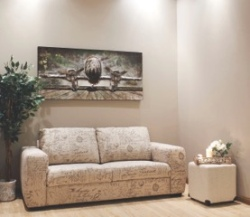Transitional décor is one of the hottest styles for your living room this season, marrying both classic and contemporary elements, it’s an easy way to bring class and elegance to your home.

Sue Scott from Grafton Everest says the fusion between classic elegance and slick minimalism is what makes transitional décor the perfect blend of old and new.
Transitional décor is one of the hottest new décor trends - it is timelessly stylish and elegantly simple - marrying the best of both vintage and modern styles for an interesting and layered end result.
Scott offers tips to successfully achieve a transitional-style living room:
Old and new
Scott says the most defining aspect of transitional décor is that it’s an elegant blend of classic pieces and contemporary touches. For this style, mixing old and new is key. Think, for example, of combinations like an old vintage lamp on a modern square coffee table.
While mixing old and new is important, some items, such as seating, are better bought new, as older couches tend to be worn and uncomfortable, and comfort and luxury are key when trying to achieve this look.

Items such as wooden side or coffee tables are better old, as vintage wood always adds a warm touch to a space. Wooden coffee tables are an easy and affordable way to introduce a touch of old world elegance to a composition.
Neutral hues
Scott says keeping your living room’s colour palette in neutral tones will help to keep things looking elegant and chic, instead of looking like a junk shop.
“Sticking to a neutral colour palette will make it easier to find classic and modern pieces that complement one another.” Organic tones of white, grey, stone, brown, and pale shades of green and blue are the ideal choice for your living room, she says.
Less is more
She says although it’s easy to over-accessorise, when trying to achieve the transitional look, it’s important to remember that less is definitely more.
“To get the most out of a transitional-style living room, make sure that you have a few well chosen, stylish pieces of furniture, rather than cluttering your space with a large collection of items.”

Scott says overdoing the décor and cluttering the space up will ruin the clean simplistic look that has made transitional décor so popular. Rather invest in a few good pieces of furniture, and compliment these with some carefully chosen décor accessories and soft furnishings.
“Remember to include ample storage, so as not to ruin the overall look of the space.”
Tons of texture
Scott says since it is advisable to keep the colour palette neutral and the overall style of your living room unfussy and clean, adding interest to your space through texture is key.
A good way to add texture is with a sofa that can blend as seamlessly with modern décor as it can with vintage items. Texture can be brought into the composition easily by adding occasional chairs that have been upholstered in interesting fabrics.
“You can choose interesting, high-end upholstery for an occasional chair as it won’t require too much thereof, and thereby achieve a piece that is packed with textural interest that will attract the eye.”

She says you can also add texture through the addition of lamp shades, soft furnishings and scatters, window dressing, rugs and collections of interesting objects d’art.
Simplistic and serene
Transitional décor means you’ll be amalgamating two distinct styles, making it important to keep things super streamlined to ensure that the overall look doesn’t appear too cluttered.
Scott says your furniture should stand as the focal style elements in your living room, while the various decorations and accessories ought to be kept to a minimum. A good way to display various items is to group them together in complementary and stylised mini collections.
When decorating, be sure to focus on the overall effect - choose pieces, such as artwork, lighting or interesting accessories that will add to and compliment your transitional living room, rather than drawing attention away from the space.
“The transitional style is both trendy and classic, making it easy to achieve. It also makes it possible to amalgamate old, sentimental pieces with new, contemporary ones.”







